Black Swallowtail Butterflies of Ohio: Presence Explained!
The Black Swallowtail butterfly (Papilio polyxenes) is a notable species in Ohio, identifiable by its black wings with yellow spots and blue bands.
Males showcase vivid yellow spots, while females have prominent blue bands. They prefer habitats with Apiaceae family plants, such as dill and parsley.
Their life cycle includes stages from egg, larvae, pupa, to adult, with critical morphological changes at each stage.
These butterflies play a pivotal role as pollinators and are prey for birds and small mammals. Conservation efforts focus on habitat preservation and reducing pesticide use. There’s much more to uncover about their ecological significance.
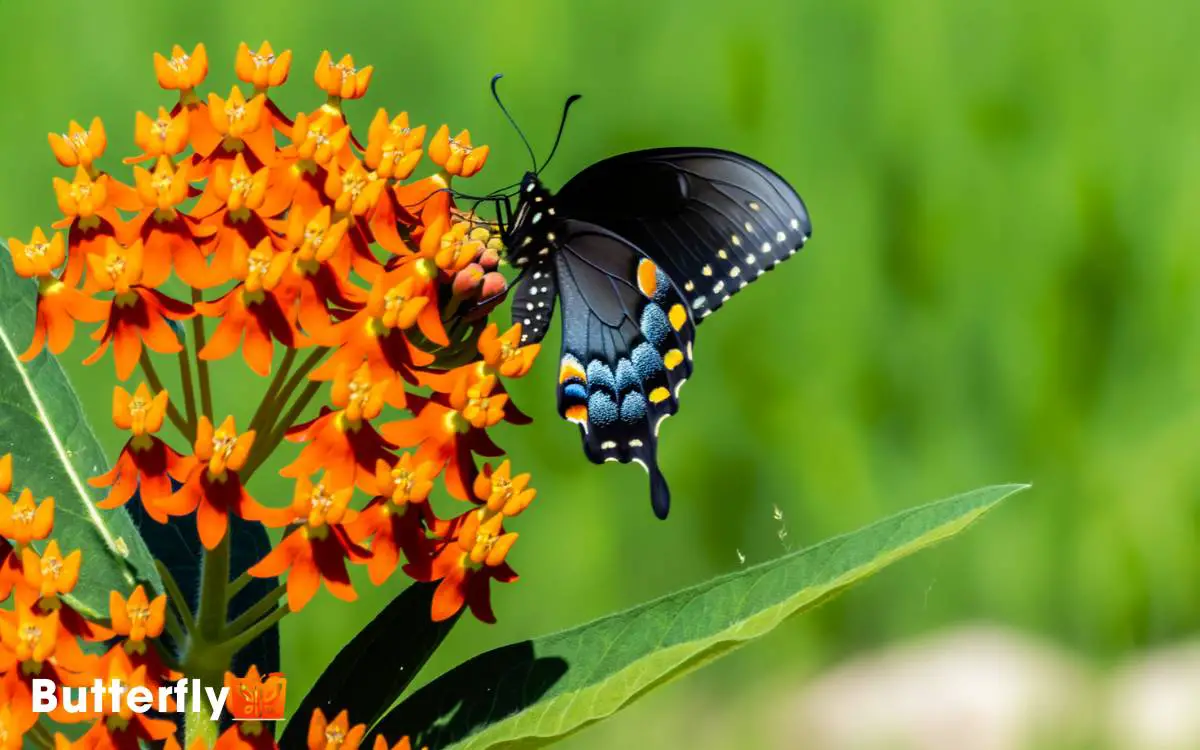
Key Takeaways
Identification and Appearance
The Black Swallowtail butterfly (Papilio polyxenes) is identifiable by its striking black wings adorned with two rows of yellow spots and a distinctive blue band that’s more pronounced in females. This species, belonging to the family Papilionidae, exhibits sexual dimorphism.
Males possess a more vivid yellow spot pattern while females display a more vibrant blue band.
Observably, the forewings feature irregular yellow markings, while the hindwings present a series of blue scales and a conspicuous red-orange eyespot near the tail. Antennae are black with minute white dots, enhancing their unique appearance.
The ventral side of the wings shows a more subdued color palette, aiding in camouflage. These butterflies epitomize the beauty and complexity of lepidopteran diversity.
Life Cycle Stages
The life cycle of *Papilio polyxenes* encompasses distinct stages that secure its survival and reproduction.
Initially, the eggs hatch into larvae, which then undergo metamorphosis to become pupae.
Egg to Larva
Upon oviposition, the fertilized eggs of Papilio polyxenes, known commonly as Black Swallowtail butterflies, undergo rapid embryonic development, leading to the emergence of larvae within approximately 4 to 10 days.
The eggs, typically laid on the foliage of host plants such as Apiaceae species, exhibit a pale yellow hue, gradually darkening as the larval stage approaches. Embryogenesis occurs within a protective chorion, where the zygote undergoes cell division and differentiation.
The larval stage, also referred to as the caterpillar phase, signifies the onset of the feeding period, characterized by voracious consumption of host plant leaves. This stage is critical for the accumulation of energy reserves essential for subsequent metamorphic processes.
The newly emerged larvae, or instars, display distinct morphological features.
Larva to Pupa
As the larva of Papilio polyxenes progresses through its instars, it undergoes several molts, shedding its exoskeleton to accommodate rapid growth and prepare for the pupal stage.
Each molt reveals a striking transformation, as the larva shifts from a black and white banded appearance to vibrant green hues adorned with black stripes and yellow spots.
Each stage symbolizes a step closer to metamorphosis, evoking awe and wonder.
| Stage | Description |
|---|---|
| 1st Instar | Black with white saddle |
| 2nd Instar | Brownish-black with white bands |
| 3rd Instar | Green with faint banding |
| 4th Instar | Bright green with distinct patterns |
These detailed stages highlight the larva’s profound adaptability and resilience, essential for its survival and eventual transformation into a pupa.
Pupa to Adult
Emerging from the chrysalis, the adult Papilio polyxenes showcases its striking black wings adorned with yellow spots and blue crescents, marking the culmination of its metamorphic journey.
This final stage of development is a tribute to nature’s intricate design, transforming from a pupa into a fully-fledged butterfly ready to explore its surroundings.
Observers can witness:
- Wing Expansion: The newly emerged butterfly pumps hemolymph into its wings, expanding them to full size.
- Coloration: The distinct yellow and blue markings become more vivid as the wings dry and harden.
- First Flight: Within hours, the butterfly takes its inaugural flight, beginning its role in pollination.
The adult stage, classified under the family Papilionidae, emphasizes both beauty and ecological significance, embodying freedom in flight.
Preferred Habitats
Black Swallowtail Butterflies (Papilio polyxenes) in Ohio exhibit distinct preferences for habitats that support their host plants, primarily from the Apiaceae family.
These butterflies thrive in areas where the climate provides warm temperatures and moderate humidity, particularly during the spring and summer months.
Observations reveal that their habitat selection is closely linked to the availability of suitable larval food sources and ideal climatic conditions.
Host Plant Preferences
The Black Swallowtail butterfly (Papilio polyxenes) shows a strong preference for host plants in the Apiaceae family, particularly favoring species such as dill (Anethum graveolens) and Queen Anne’s lace (Daucus carota).
These butterflies exhibit an affinity for specific phytochemicals found in these plants, facilitating larval development and survival. Observations indicate a pattern in their oviposition behavior, often selecting plants in open, sunny habitats.
- Dill (Anethum graveolens): Larvae feed voraciously on the feathery leaves, ensuring rapid growth.
- Queen Anne’s lace (Daucus carota): The wild carrot’s umbrella-shaped flowers provide essential nutrients.
- Parsley (Petroselinum crispum): Another favored host, supporting larval stages through its lush foliage.
This plant selection underscores their ecological niche and adaptability.
Climate and Seasonality
Climate and seasonality profoundly impact the habitat preferences and distribution of the Black Swallowtail butterfly (Papilio polyxenes) across Ohio.
This lepidopteran thrives in temperate climates, favoring open fields, gardens, and meadows rich in host plants like members of the Apiaceae family.
Ohio’s variable weather patterns dictate its activity, with adults emerging from pupae in late spring and continuing to breed through early autumn.
During cooler months, Black Swallowtail larvae undergo diapause, a physiological state of dormancy, to survive winter. Warmer temperatures in spring trigger pupation and subsequent emergence.
The butterfly’s phenology aligns closely with the seasonal availability of nectar sources and oviposition sites, underscoring the intricate interplay between climate, seasonality, and habitat selection for this species.
Role in Ecosystems
Swallowtail butterflies, specifically Papilio polyxenes, play a significant role as pollinators in Ohio’s ecosystems, facilitating the reproduction of a variety of flowering plants.
These lepidopterans exhibit remarkable adaptations that enhance their ecological contributions. Observations indicate that their proboscis structure permits efficient nectar extraction, benefiting numerous angiosperms.
Additionally, they serve as prey for various avian species, thereby maintaining trophic dynamics.
Their presence supports:
- Pollination of native flora – ensuring genetic diversity and plant propagation.
- Food web stability – acting as an important food source for birds, spiders, and small mammals.
- Biodiversity enhancement – promoting habitat richness through their interactions.
Papilio polyxenes exemplify the intricate interdependencies within Ohio’s ecosystems, underscoring the importance of preserving these vibrant pollinators.
Conservation Efforts
Recognizing the ecological significance of Papilio polyxenes, conservationists have initiated targeted efforts to safeguard their habitats and guarantee their continued role in Ohio’s ecosystems.
These initiatives involve habitat restoration, ensuring the availability of host plants like Apiaceae family members, and mitigating pesticide use.
Monitoring populations through systematic surveys aids in evaluating the health and distribution of these Lepidoptera. Conservation biologists collaborate with local communities to promote awareness and participation in habitat conservation.
Gardening for Black Swallowtails
Creating a butterfly-friendly garden for Papilio polyxenes involves strategically planting host species from the Apiaceae family, such as dill (Anethum graveolens), parsley (Petroselinum crispum), and fennel (Foeniculum vulgare), which provide essential nourishment for their larvae.
These plants support the caterpillar stages and guarantee a thriving population.
To create a perfect habitat, gardeners should:
- Plant nectar-rich flowers: Include species like Echinacea purpurea (purple coneflower) and Asclepias tuberosa (butterfly weed) to attract adult butterflies.
- Provide water sources: Shallow dishes filled with water and pebbles allow butterflies to hydrate safely.
- Maintain pesticide-free zones: Avoid chemical treatments to preserve a safe environment for all butterfly life stages.
Conclusion
To sum up, the Black Swallowtail butterfly (Papilio polyxenes) is a captivating species vital to Ohio’s ecosystems. With a wingspan ranging from 6. 9 to 8. 4 cm, they’re easily recognizable. These butterflies are commonly found in gardens, meadows, and open fields, where they play a crucial role in pollination. Interestingly, black swallowtail butterflies New Jersey populations thrive in similar habitats, feeding on plants like milkweed and parsley. Their striking black wings with yellow and blue markings make them a favorite among butterfly enthusiasts.
It’s noteworthy that studies show that up to 70% of larvae don’t survive to adulthood due to predation and environmental factors.
By understanding their life cycle and habitats, and promoting conservation and gardening practices, we can help guarantee the survival of these remarkable pollinators in Ohio.


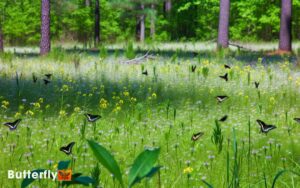
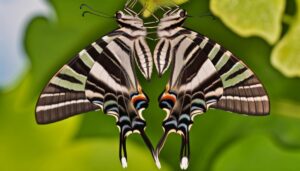
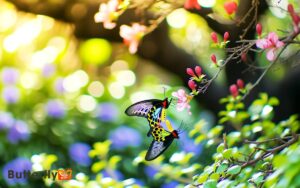
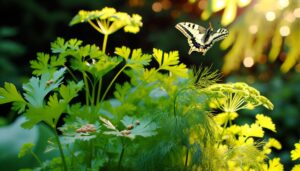
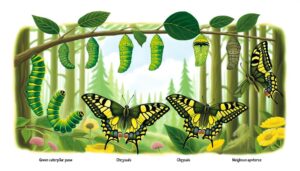
Your article helped me a lot, is there any more related content? Thanks!
Thank you for your sharing. I am worried that I lack creative ideas. It is your article that makes me full of hope. Thank you. But, I have a question, can you help me?
Your point of view caught my eye and was very interesting. Thanks. I have a question for you. https://www.binance.com/el/register?ref=IQY5TET4
Thank you for your sharing. I am worried that I lack creative ideas. It is your article that makes me full of hope. Thank you. But, I have a question, can you help me?
Your point of view caught my eye and was very interesting. Thanks. I have a question for you.
Thank you for your sharing. I am worried that I lack creative ideas. It is your article that makes me full of hope. Thank you. But, I have a question, can you help me?
Thanks for sharing. I read many of your blog posts, cool, your blog is very good.
Can you be more specific about the content of your article? After reading it, I still have some doubts. Hope you can help me.